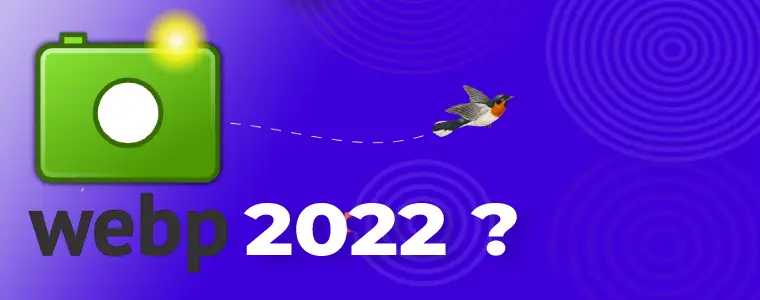The challenge of being a web publisher is that technology runs in the fast lane every day, so you’d better stick your running shoes on with superglue and keep up!
WebP images are not a new technology. They were first announced by Google in September 2010, but it took Google till April 2018, before releasing the first stable version of its supporting library.
JPEG (or jpg) images were the leading web image format used in 2018 – and still is today – but WebP was designed to be smaller than JPEG files for comparable image quality.
There was one catch to using WebP images back in 2018 – only Google’s Chrome browser supported them!
Today the initial browser support issue has evaporated – the door is WIDE open to use WebP images on your websites.
Should I use WebP images on my website in 2022?
Well instead of answering that question, here’s the answer to why most web publishers still don’t use WebP images as their default image type:
- It’s created by Google! Yes this is becoming an issue for a lot of people as ‘big tech’ chews into technology, pushing out smaller, and sometimes better players.
- WebP is still not 100% supported in all (old) browsers and image handlers. The emphasis here is on OLD!
- And of course the old allegory – why fix something if it’s not broken! I call this ‘banking syndrome’ – it’s the reason why some banking systems still run on Windows XP that expired in 2014!
Should you use WebP images on your website as your default image format in 2022 - here's why I would say YES
Here’s why I say ‘yes‘ – you should strongly consider using WebP images as your default image type for your WordPress and other websites.
- Just a few months ago Apple finally tossed their ‘we don’t like Google’ hatchet into a flooded river and adopted WebP for Safari!
- I run on a Mac but never use Safari except on rate occasions to do testing. Apple is great for hardware, but when it comes to software like browsers, I think they gave their D teams the creation job! I use Brave browser these days.
- All the latest versions of browsers now support WebP as of Sept 2022.
- You can view a full browser compatibility list for WebP here.
And there's more ...
More reasons to use WebP images on your website in 2022
WebP images are often 50% smaller than JPG images and 200% smaller than PNG images
The WebP official figures are :
- 25-34% smaller than a comparable JPEG image
- 26% smaller than a comparable PNG image
However from real-world use I have found comparative quality JPEG images are usually double the equivalent quality WebP image size.
Take this WebP image as an example:
(We have lots of white bunnies on our farm!)

WebP
2.7kb

JPG (jpeg)
5.2kb

PNG
18.3kb
As you can see, there is not a lot of difference if you are viewing these on a laptop or tablet.
If you use a massive monitor then yes, you will see a difference, but unless you had all three images lined up like this, you would not normally notice any quality issues.
And the key to remember is that its likely over sixty percent of your site visitors are now viewing your site with a mobile device!
[ Have you checked your mobile stats recently – you should be keeping an eye on these! ]
Google Mobile First says your site must be designed for Mobile
If you have a nice big team to manage your web publishing, then you can create three different image versions for each key view device – desktop – tablet – mobile.
However, I am sure like me, you have a small team or you are the ‘team’!
Mobile First means that your web pages will be judged by Google at mobile speeds.
This part of the Google Page Experience, and wrapped up in Google’s Core Web Vitals, means you have to make sure your site pages load lightening fast at current mobile network speeds.
If you saw a massive drop in your web traffic after March 2018 now you know what probably caused this drop! It’s likely your pages – like most other site pages – failed Google’s new speed metric.
Since late 2018, I have had a flood of page speed optimization work, fixing up my clients mobile page speed rankings.
If you use WebP optimized images you can usually get away with using the same image for all viewports – desktop – tablet and mobile.
Using the same image for all viewports often means a huge time saving when it comes to content creation.
On this site I couple the use of WebP images with WP Rocket lazy loading and Perfmatters excess code stripper.
I also host this site on a Digital Ocean VPS (virtual private server) managed fully by Cloudways – so all my pages load lazer fast and my total monthly site cost is less than $15!
- This page FULLY loads in : 809ms (less than 1 second) at Broadband desktop speeds: https://gtmetrix.com/reports/crunchlets.com/hMxn61on/
- And FULLY loads in just : 1.3 seconds (less than 1/2 second slower) at Mobile LTE speeds: https://gtmetrix.com/reports/crunchlets.com/mPGZl0m2/
And most importantly – both desktop and mobile speeds pass ALL Core Web Vital metrics.
The total image ‘load’ for this page is just 30.1kb for 6 image request
WebP 1666% usage Increase in 2 years
SVG Image usage on websites
If you look at the chart below, you will also see a huge increase in another image format to add to your page speed optimization radar – SVG which has grown from 27% to nearly 52% in the same two year period. SVG is a vector ‘lossless’ image format that is perfect for simple images like icons.
Source: W3Techs.com
Who wants more FREE traffic?
It used to be a tricky process to keep all your software updated, but with modern systems and fast internet, this is now less of an issue.
Computer users who keep software updated also fit into a clear market niche vs those who don’t.
Those who update software regularly are people who are more proactive and make faster decisions.
So my question to you is:
Do you want more people coming to your website who will buy more of your products and make purchasing decisions faster?
If your site loads faster than your competitors, and your content quality is basically the same – you are more likely to win the Google ranking game and get more free site visitors.
Not sure about you, but that smells like free money to me!
Using technologies that give you a clearly defined and proven speed advantage just makes logical sense.
And – if you lose a couple of ‘late starters’, then the extra site visitors from ranking better on Google, more than makes up for any limited losses.

want some FREE speed?
I will send you a free 100% coupon for my latest super-in-depth speed cheat sheet worth $47 that shares with you my step-by-step easy speed optimisation process that I use to get red-hot speed results every time… PLUS 5 key speed tips you can use on your site today – All good for any site.



